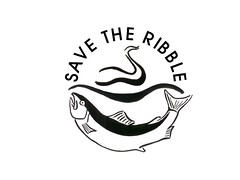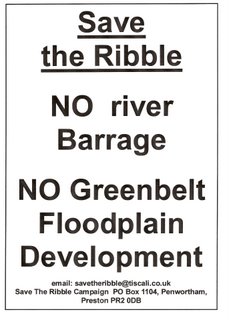New Ribble RSPB Reserve takes a mighty leap forward!
Excellent news for Ribblesiders as the RSPB announce work can now begin in earnest on their new wetland nature reserve on the Ribble, at Hesketh Out Marsh on the western side of the River Douglas.

Pink-Footed Geese arriving on the Ribble at Marshside (photo RSPB).
Tony Baker, RSPB Ribble sites manager, announced that the RSPB have recently purchased the land, and now excavation work can begin to recreate the creeks and pools the saltmarsh and mudflat habitat will need before this area can be returned to the sea.
The RSPB are working closely with the Environment Agency, English Nature, and Lancashire County Council on this project, which will help counteract the loss of areas of this vital habitat to rising sea levels, as well as contributing a valuable new reserve to the Ribble and the aims towards the creation of the Ribble Estuary Regional Park.
Hesketh Out Marsh Reserve:
The Hesketh Out Marsh Reserve will return 170 hectares of wetland habitat to the Ribble’s ecosystem, saltmarsh which was drained in the 1980s for farmland purposes, and once the excavations and new inner walls are completed, 4 breaches will be made in the old sea defences to allow the tides to wash into the area.

Confluence of the River Douglas with the Ribble near Hesketh Out Marsh.

Dow Brook mudflat creeks on the opposite shore to Hesketh Out Marsh at Freckleton.
Work should start in March next year, when the old creeks will be re-dug, with the soil removed from them being used to construct a new embankment to Hesketh Out Marsh East, and strengthening existing sea defences around Hesketh Out Marsh West.
This recreated habitat will be an important part of the Ribble’s wetland ecosystem, homing numerous bird species, including black-tailed godwits, dunlins, avocets, redshanks and wigeons.

Redshank on the Ribble floodplain (RSPB).
"This new reserve will be a mix of wetland habitats, including saltmarsh, saline lagoons and muddy creeks and will make a major contribution towards national targets for coastal saltmarsh creation,” said Tony Baker of the RSPB.
It will also include viewing points for visitors, and improved footpaths which will contribute to a rationalisation of the Lancashire Coastal Way, the Ribble Way being a famous contribution to this fantastic resource for local people and visitors alike.

"The seagulls and the sun make friends" by 'I': Children and adults enjoy the wildlife the Ribble brings.
Habitat restoration:
It is because of the threat of sea level rises that salt marsh and mudflats are protected habitats, included in the UK Priority Biodiversity Action Plan Habitats. The onus is on the Environment Agency to create 2,000 hectares of new habitat every year, at the same time as ensuring that no habitats are lost through flood risk management projects, and they have established the Regional Habitat Creation Programme to implement this. You can read more about Biodiversity Action Plan Habitats here.
As well as contributing a significant new area of wetland habitat to the Ribble, this new reserve will help to protect the Ribble area from flooding, and also adds an important contribution to the developing Ribble Estuary Regional Park.
Flood Defences.
As you can read in our Mudflats and Salt Marsh article, mudflats and saltmarsh are also effective and cost-efficient flood defences, and this recreation of wetland habitats formerly claimed from the sea is the Environment Agency and Defra’s preferred flood risk management strategy (called “managed realignment”) as it is the most sustainable and beneficial means of protecting land from rising sea levels and river plain flooding.
Ribble Estuary Regional Park:
Work is underway to designate the Ribble Estuary a Regional Park, offering a massive 30 km2 wildlife haven and tourist destination on the Ribble Estuary.
The Ribble is the UK’s most important river estuary for birds, and a steering group led by key partners Lancashire County Council, Sefton Borough Council, RSPB, English Nature and the Environment Agency is taking forward the Regional Park idea.
The North West Development Agency (NWDA), who have assisted the RSPB and the Environment Agency with the creation of the new reserve at Hesketh Out Marsh, are the body who would make the final decision on the creation of the Ribble Estuary Regional Park.

The Ribble Estuary.
A positive decision from the NWDA would allow the focus of the Ribble Estuary Regional Park to be on sustainable leisure and environmental projects which would open the Ribble to better public access, allowing locals and visitors alike to experience its internationally important wildlife and habitats. This would boost the local economy at the same time as protecting this vital habitat for the future.
In case any readers might consider a Ribble barrage to be a positive contribution to the Ribble Estuary Regional Park, it is worth reiterating here that a barrage would interfere with the free-flow of water and the nutrient-rich silts and thereby put this delicately-balanced ecosystem at risk. You can read more on the damage barrages cause here.
Laurence Rose, North West Regional Director of the RSPB, said of the Ribble Estuary Regional Park project:
"It is vital that we conserve our natural heritage, not only for the wildlife dependent on these areas, but also to benefit local businesses and economies. Studies have shown that visitors to RSPB reserves spent an estimated £11 million in local economies. With an increasing number of people enjoying our natural heritage and wildlife, places like the Ribble Estuary will become even more important in the future."
County Councillor Brian Johnson, Lancashire County Council's cabinet member for Urban and Rural Regeneration, said:
"The Ribble Estuary is one of Lancashire and the North West's most valuable natural assets and at the moment its potential is untapped. We see the NWDA's decision on Regional Parks as a possible springboard that could draw in funding for a range of projects. Regeneration is not just about tidying up urban grot spots - it's also about using our expertise to create sustainable economies for rural areas. Projects like this often lead to improvements in the image and environmental quality of the area, which in turn help to attract new investment. That is why we have joined with the RSPB and other organisations in the area to give our support, should the NWDA go for the Regional Park idea."
To read more about the Ribble Estuary Regional Park, click here and here.
If you haven't been keeping in touch with some of our local wildlife through AutumnWatch, you can catch up here!
Phil Widdows recently noted the Hesketh Out Marsh scheme on his blog, believing this is a boost to Preston City Council's Riverworks barrage!!! He says:
"Save The Ribble are outraged by the [barrage] scheme, saying that the birdies which currently enjoy nothing more than a good root and a rummage on the mudflats exposed every low tide will all starve to death if the barrage effectively stops that stretch of the river from being tidal.Well, with a brand new 170 hectare nature reserve on their doorstep, courtesy of the RSPB, the birdies can jolly well move downstream a bit and have a root and rummage there, can't they?You know, if I was a cynical man, I might just suspect that someone in Preston Council is rubbing their hands with glee and laughing a Machiavellian guffaw right now. Save The Ribble's ecological objections to the barrage scheme have been holed below the waterline - and all thanks to the Royal Society for the Protection of Birds."
Phil Widdows' article unfortunately misses the little matter that the barrage would not only drown the upriver mudflats under permanently raised water levels, but would also risk starving the vast majority of the Ribble's mudflats and salt marsh out on the Estuary - including the newly created Hesketh Out Marsh Reserve!!!
As pointed out above, because of the risk to these habitats from sea level rises, the Environment Agency have to create new habitats every year, just to maintain the status quo.
Unfortunately for Preston City Council, they can't say "it's ok to drown the upriver mudflats as there are new mudflats at Hesketh Out Marsh to make up for it", just like one person can't say it's ok to burn down another person's house because someone has built them another house somewhere else!
(But as Phil says, they may well try!)
Contact savetheribble@tiscali.co.uk
Labels: biodiversity, hesketh out marsh, rspb, wetlands















3 Comments:
This is brilliant news!
Fantastic for the area, the river, the people and the wildlife!
Well done the RSPB and all those involved.
And it's only 10 mins cycle ride from my front door - great!
Stuart
Sea Fishing and Walking in the UK
I think this project is an excellent idea, it creates economic opportunity and an environmental haven, a definate win-win.
I would like to see a more quantifiable analysis of the impact that the proposed barrage would have on this new reserve. I have heard conflicting points of view, would it not be possible, once the barrage was built, to expand or recreate the upriver mudbanks?
Many Thanks
Unfortunately not: the upriver mudflats would be permanently drowned under the constant higher water levels, and those downriver - which is of course the vast majority of the Ribble's mudflats and saltmarsh - would be at risk of silt & nutrient starvation (as a great deal of the Ribble's silts would be impounded behind the barrage) AND they would be at risk of erosion as the Ribble's tidal movements and downflow movements would change, thus could actually erode the mudflats which remain.
It IS possible, however, to invest on the growth of tourism without building a barrage, and this is what PCC should be concentrating their energies on, rather than risking an entire habitat on a single-minded and narrow-minded barrage scheme. It's not like boats can't use the Ribble without a barrage as boats do use the Ribble as they have for centuries.
We would also like to see full environmental impact assessments completed, not just regarding the new reserve at Hesketh Out Marsh, but the whole Ribble corridor, and these should be the priority rather than delivery strategies and economic development plans.
Thanks for your comment!
Post a Comment
<< Home